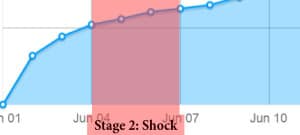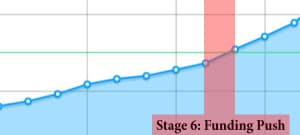
Hello! Let me begin by introducing myself. I’m Teale Fristoe, the guy behind Nothing Sacred Games and the newest member of the League of Game Makers! I’m extremely excited to be joining the fantastic folks here at the League.
Today I thought I’d discuss something that few people realize they’re getting themselves into when they start a Kickstarter campaign: a total emotional roller coaster. I think we’re all aware that a successful campaign can be exhilarating, and a floundering campaign can be depressing, but what people don’t realize is that every campaign provides moments of both ecstasy and crushing defeat.

Teale, ecstatic with the physical proof of his Kickstarted Shadow Throne.
And I should know… I’ve successfully completed two Kickstarters and am just finishing up my third campaign. My first was Corporate America, then came Shadow Throne, and Birds of a Feather has just a day to go! So you might say I’m still riding the roller coaster as I write this.

Above you can see Shadow Throne’s funding graph. I’m not sure if it’s totally typical for a Kickstarter, but it’s close enough to illustrate many of the points I’d like to make today. So let’s get started with the exciting beginning!
STAGE 1: INITIAL THRILL
 If you’ve done your homework, your first few days, and especially your first day, should be a truly thrilling experience. Your friends and family will all rally behind you, you’ll see a steady stream of new pledges coming in, and you’ll hear from friends from long ago as word spreads about your project through social media. You’ll feel like the whole world is cheering you on!
If you’ve done your homework, your first few days, and especially your first day, should be a truly thrilling experience. Your friends and family will all rally behind you, you’ll see a steady stream of new pledges coming in, and you’ll hear from friends from long ago as word spreads about your project through social media. You’ll feel like the whole world is cheering you on!
Note that if this doesn’t happen, it might be time to step back and take a good, long look at your game and your project. Did you test your game enough? Do enough people know about it? Did you price it right? Does it look good on the campaign page? Do you have reviews to convince people that the game is playable and fun? If your project doesn’t have a strong opening day, it doesn’t mean certain doom, but you’re looking at a long, hard struggle.
STAGE 2: SHOCK
 After the first few days, your project will still be getting backers, but the rate will have plummeted. Most of your friends and family have already offered their support, so now it’s just random people stumbling upon your project, and this happens less than you might expect. You may still be making progress towards your goal, but it feels like the world is falling out from under your feet.
After the first few days, your project will still be getting backers, but the rate will have plummeted. Most of your friends and family have already offered their support, so now it’s just random people stumbling upon your project, and this happens less than you might expect. You may still be making progress towards your goal, but it feels like the world is falling out from under your feet.
In a lot of ways, this is just a reaction to your initial elation. It’s like how lukewarm water can feel scalding hot when you dip your freezing hand in it. You’re coming back to reality after being in the clouds, and the landing can be really difficult. But don’t worry, you’ll get used to it.
STAGE 3: ACCEPTANCE
 Pledges probably haven’t slowed down too much, but you’ve gotten used to it. You’re no longer defining normal based on the initial thrill–you’ve accepted that it’s ok if you get a dozen backers a day and not one hundred. Hours will go by without any new supporters, but you’ll shrug it off and remember that there are other good things in life.
Pledges probably haven’t slowed down too much, but you’ve gotten used to it. You’re no longer defining normal based on the initial thrill–you’ve accepted that it’s ok if you get a dozen backers a day and not one hundred. Hours will go by without any new supporters, but you’ll shrug it off and remember that there are other good things in life.
This is a healthy attitude, and one you should probably come into your Kickstarter with (but even if you do, that initial funding rush will knock it right out of you).
STAGE 4: DISAPPOINTMENT
 You may have accepted the new normal, but that doesn’t mean you don’t crave that initial rush again. And you’ve schemed to reach it again… you’ve scheduled reviews, you’ve bought advertising, you’ve signed up to be a guest on podcasts. Any minute now, those backers will come pouring in!
You may have accepted the new normal, but that doesn’t mean you don’t crave that initial rush again. And you’ve schemed to reach it again… you’ve scheduled reviews, you’ve bought advertising, you’ve signed up to be a guest on podcasts. Any minute now, those backers will come pouring in!
The problem is that no one method of outreach is extremely effective, and many do nothing at all. It’s one of the reasons I do so little advertising these days. It’s bad enough when your big review fails to bring in the tidal wave of new backers you hoped for, but it feels much worse when you feel like you’re throwing money directly into the trash can.
Truth be told, even though individual attempts at outreach often disappoint, taken together they make a big difference in any campaign. It may feel like your campaign is only getting a trickle of backers, but without ads, reviews, and internet appearances, those backers never would have heard about your game.
STAGE 5: BETRAYAL
 Starting about half way through your campaign, and intensifying after you fund and towards the end, you’ll start seeing backers cancel their pledges. Every time you receive an email announcing a lost backer, it feels like a friend stabbing you in the back. Why did they do it? Was it something you said? Did they hate your game after trying the PnP? Were they just toying with you from the beginning?
Starting about half way through your campaign, and intensifying after you fund and towards the end, you’ll start seeing backers cancel their pledges. Every time you receive an email announcing a lost backer, it feels like a friend stabbing you in the back. Why did they do it? Was it something you said? Did they hate your game after trying the PnP? Were they just toying with you from the beginning?
In reality, there are a ton of legitimate reasons backers leave campaigns, and unless your backers are leaving in droves, you shouldn’t feel bad about it. Some Kickstarter backers watch campaigns by backing them. Some back a bunch of campaigns, then cancel after they’ve decided which ones look most appealing. Some want to see you reach your goal, but ultimately are more interested in you succeeding than getting your game. And sometimes life just catches up and backers can’t afford what they thought they could. Whatever the actual reason, it’s best to not let cancelled pledges get you down.
STAGE 6: FUNDING PUSH
 When you start getting close to your goal, you won’t be the only one getting excited. Your whole backer community will be there watching the numbers tick up, refreshing the page repeatedly and spreading the word. The energy will be infectious, and you’ll once again be on top of the world.
When you start getting close to your goal, you won’t be the only one getting excited. Your whole backer community will be there watching the numbers tick up, refreshing the page repeatedly and spreading the word. The energy will be infectious, and you’ll once again be on top of the world.
But don’t get too cozy. Unless this push combines with another (for example, Shadow Throne’s funding push directly led to its rush to the finish line), you’re going to have to go through stages 2 and 3 all over again.
STAGE 7: RUSH TO THE FINISH LINE
 Kickstarters tend to finish just like they start, full of excitement and fun. Things really pick up when the 48 hour reminder emails go out, then escalate as more people try to get in on the project before the clock strikes 0. The ending is usually a little less extreme than the beginning, but believe me, it will still be plenty exhilarating.
Kickstarters tend to finish just like they start, full of excitement and fun. Things really pick up when the 48 hour reminder emails go out, then escalate as more people try to get in on the project before the clock strikes 0. The ending is usually a little less extreme than the beginning, but believe me, it will still be plenty exhilarating.
TAKEAWAYS
Part of my goal in writing this article is to prepare you for what you’ll go through when running a campaign. Even though your exact experience will be different, knowing when to expect highs and lows can help keep you balanced, which is important when you’re doing something extremely public.
But it’s also useful to break campaigns down in this way. It helps explain something I’ve been doing over the course of my campaigns: making them shorter. This tends to cut out the middle part, which is more stressful and doesn’t result in that many pledges, but leaves the exciting ends intact.
It also helps explain why stretch goals are so effective. You get a big push when you come close to hitting your goal, so why not always be close to hitting a goal?
I’m curious to hear about your experiences. Did I miss any highs or lows? Is there a better way to think about the emotional roller coaster? How is it similar or different from the backer perspective? Let me know in the comments!
By the way, if you want to hop on the final stretch of a roller coaster, the Birds of a Feather Kickstarter doesn’t end until tomorrow. It’s been a wild ride so far!








